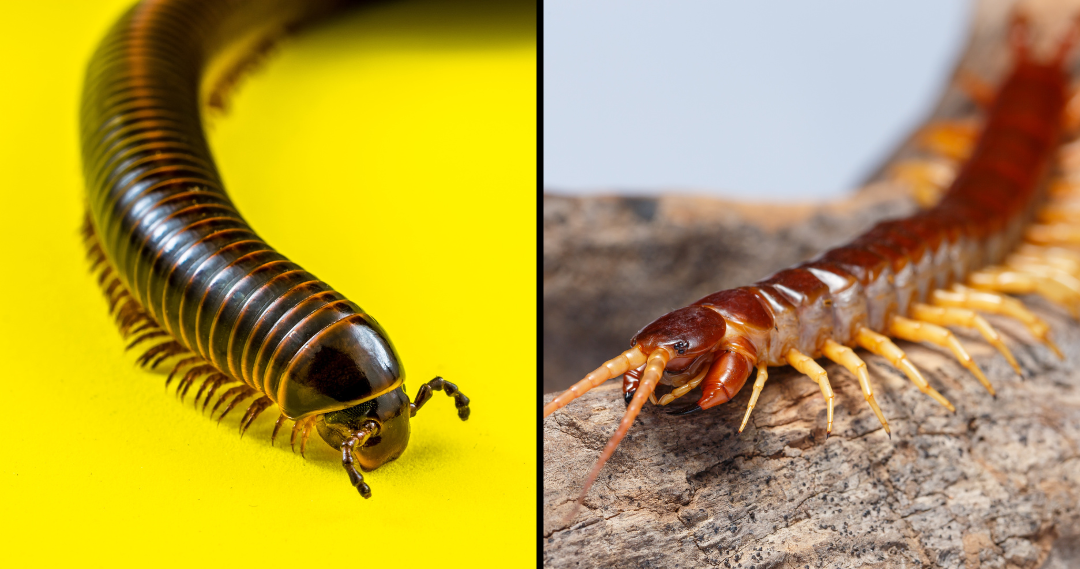When people send me photos of creepy crawlies for identification, I often see some usual suspects. Among the most common invertebrates that people encounter in gardens and households are millipedes and centipedes. After I have explained that they have one or the other, folks are quick to ask how I knew the difference. Could I really have counted all those legs? Absolutely not! However, it’s actually much easier to tell the difference between millipedes and centipedes.
In this Naturalist Answers post, let’s explore the many differences between millipedes and centipedes so you can tell them apart on your own.
Same-same, but different
First things first, it’s important to recognize that centipedes and millipedes look similar to one another for a reason. In nature, things typically look similar for one of two reasons:
- Being taxonomically related
- Convergent evolution
Convergent evolution refers to things that have adapted themselves to similar conditions or functions. Because the number of designs or behaviors that work well in a given situation is limited, more often than not they look like each other. For example, not all trees come from the same ancestor. In fact, there are many groups of trees that are totally unrelated, but developed the general shape and structure of a tree. Why? Because it works!
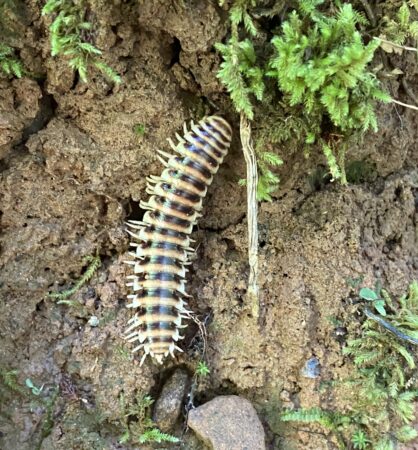
By contrast, similarities due to taxonomic relation come from actual shared genetics between groups. This is kind of like how people who share genes, like close family members, will look similar. Except in this case, the difference is between species, genera, families, or higher taxonomic groups. This is why, for example, butterflies and moths look pretty similar. This is because they share a common ancestor and are related groups.
The same is true for millipedes and centipedes. These two groups share a common ancestor and are thus part of a shared group of organisms.
The Myriapoda: Legs-a-Plenty
As it turns out, these many-legged creepy crawlies are related, but not super closely. They both belong to the subphylum Myriapoda which translates to “ten thousand feet” in Ancient Greek. These are all terrestrial arthropods, meaning that they are armored with jointed appendages like insects and live on land.
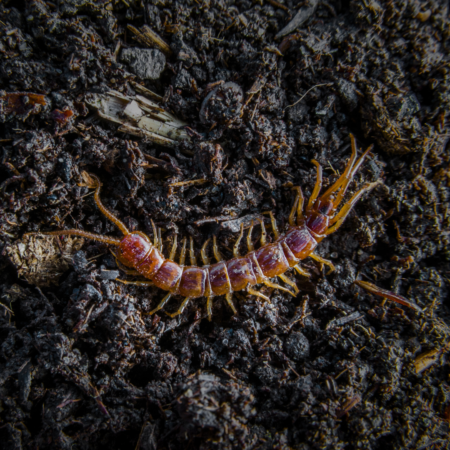
Most myriapods have one pair of antennae, typically simple eyes, and you guessed it, lots of legs. Furthermore, their bodies are elongated and split into segments, to which the legs attach. Importantly, they are not insects, nor are they arachnids like spiders and scorpions, nor crustaceans like roly-polies or lobsters. They’re a whole different thing! Unlike insects and arachnids, myriapods don’t have a waxy layer around their exoskeletons. Because of this, they are vulnerable to drying out and they keep to moist places.
But let’s get down to their differences.
Centipedes: Quick and Aggro
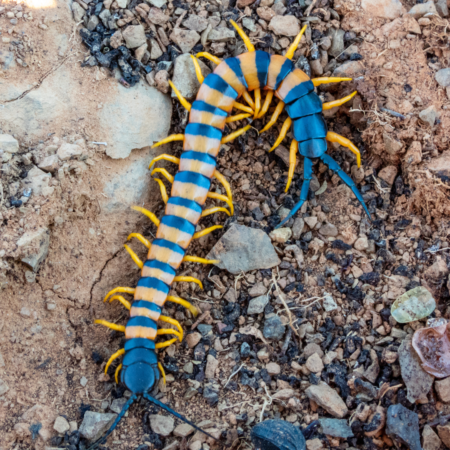
Centipedes belong to the class Chilopoda, which contains nearly 3,000 species throughout the world, with loads of species in tropical areas. Unlike millipedes, centipedes are predators, occupying a totally different part of the food web than their cousins. This means that centipedes have to be equipped for chasing down and subduing or killing prey. This lifestyle leads to several adaptations that help tell the difference between millipedes and centipedes. Centipedes have:
- Two legs on every body segment, coming out the sides for better acceleration and maneuverability.
- Long antennae for “smelling” and detecting prey
- Modified, sharp front legs that extend under their head, and which can inject venom into prey
- Very quick movement and rapid acceleration. You won’t see them ambling along!
- Typically flat, streamlined heads
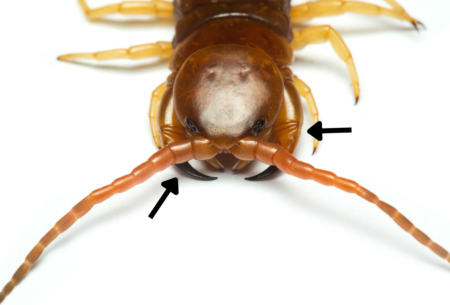
Those special limbs, which are responsible for any bite from a centipede, are known as forcipules. They are unique to centipedes and are one of the major reasons why it’s good to know the difference between millipedes and centipedes. Handling a millipede is typically harmless (unless you like licking your hands a lot), while handling centipedes can be very painful. A quick pinch with the sharp forcipules is painful enough, but the accompanying injection of venom can leave lasting pain or even put you in the hospital. These forcipules are also the origin of the centipedes class name, where chilopoda comes from Ancient Greek for “lip” and Latin for “foot”. These lip-feet are the business end of the centipede!
A Familiar Centipede
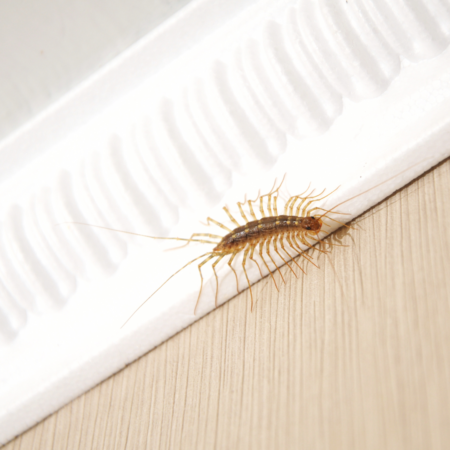
The centipede most people are familiar with is the house centipede Scutigera coleoptrata, which has long legs and “tails” that stream behind it as it runs. It’s fast and very common in households, where it can elicit screams as it runs across the floor between hiding places. House centipedes are beneficial household bugs, however, and eat small roaches and other pests. They aren’t dangerous and are likely to bite only when handled roughly. Even if you can convince one to bite you, house centipedes’ venom is not known to be dangerous.
Millipedes
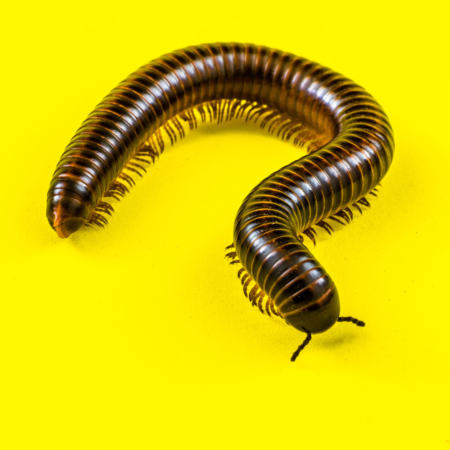
Millipedes belong to the class Diplopoda, which means double-feet. Compared to centipedes, millipedes are very chill and life a relaxed lifestyle. Rather than being predators, they are primarily detritivores, feeding on fungi, dead plant matter, rarely feeding on parts of life plants. For this reason, you shouldn’t be worried about seeing them in your garden! They might help break down leaf litter and will rarely eat any living plants. Millipedes often like to burrow through the ground or under leaves, and are slow-moving because they don’t need to chase or kill their food. Their lifestyle leads to several characteristics in contrast to centipedes:
- Four legs on every body segment, coming out from below. This is slower but provides more power for burrowing through soil and leaf litter.
- Short, bent antennae for smelling food, but small enough not to interfere with burrowing.
- Chewing mouthparts located underneath the head.
- Slow movement, and a tendency to curl up into a spiral when frightened.
- Big, rounded, blunt heads for burrowing.
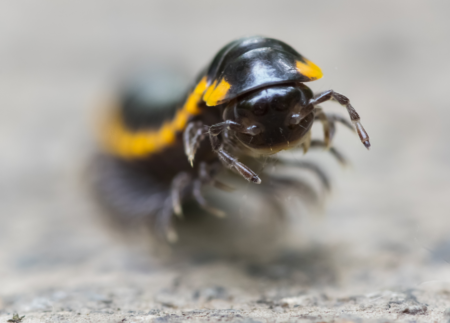
Millipedes are generally harmless animals, and their primary defense is to curl into a spiral-shape when scared. When curled up and playing dead in that way, they may secrete defensive chemicals to ward off predators. These are typically a little sticky or have a foul odor. However, in some species they may be toxic, and you should avoid eating with your hands if you have roughly handled a millipede. Scientists have even documented lemurs intentionally ingesting toxic millipede chemicals for a narcotic effect!
Millipedes in the home
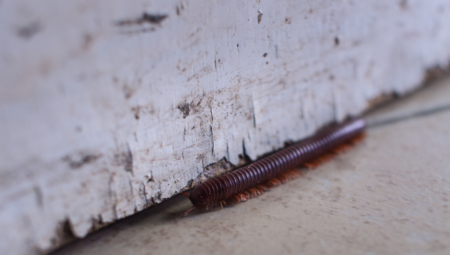
Millipedes will sometimes show up in homes, and this is typically a sign of a moisture-related problem like a leak. As with other myriapods, they need to stay relatively moist to survive, and will only show up places that are somewhat wet. Since they are detritivores, their presence might also indicate that there is rotting wood or other material upon which they are trying to feed. Millipedes are unlikely to do any damage to your home, but seeing lots of them should warrant inspection for leaks and other problems.
Recap: The major differences between millipedes and centipedes
So, here’s the rundown on centipedes vs. millipedes:
- Millipedes are like trucks in low gear. Lots of power, really slow. Centipedes are like sports cars; fast and maneuverable.
- While millipedes are chill detritivores, centipedes are aggressive predators
- Millipedes are typically safe to handle, although they may secrete smelly or sometimes poisonous chemicals onto your skin. These are typically not dangerous unless ingested. By contrast, centipedes are likely to inflict a very painful bite.
- Centipedes have stabby forelimbs on their faces, and have a sleek profile for attacking prey. On the flipside, millipedes have big, blunt heads for pushing through the leaflitter.
- While millipedes have four legs per segment, centipedes have two.
- Millipedes have short, bent antennae, and centipedes typically have long ones.
Thanks for reading about the difference between millipedes and centipedes!
Have you had an encounter with any many-legged critters lately? Let us know in the comments, or using the Contact page. If you enjoyed this article, please share it via social media and follow Gulo in Nature to stay up to date with the latest posts.

